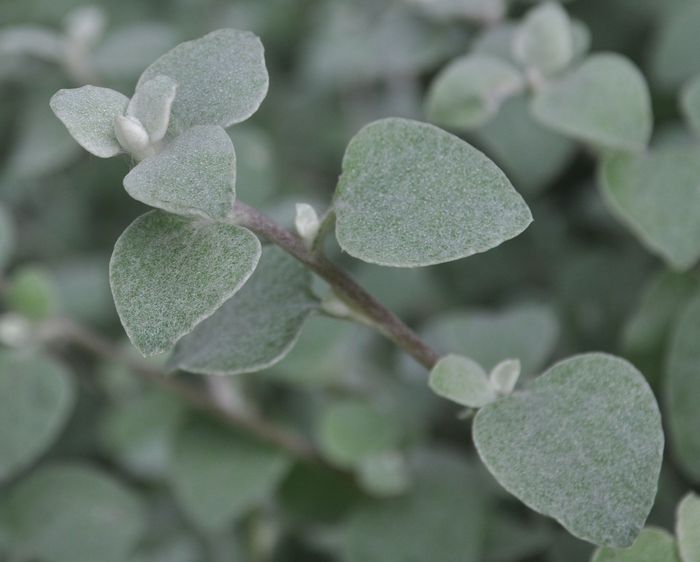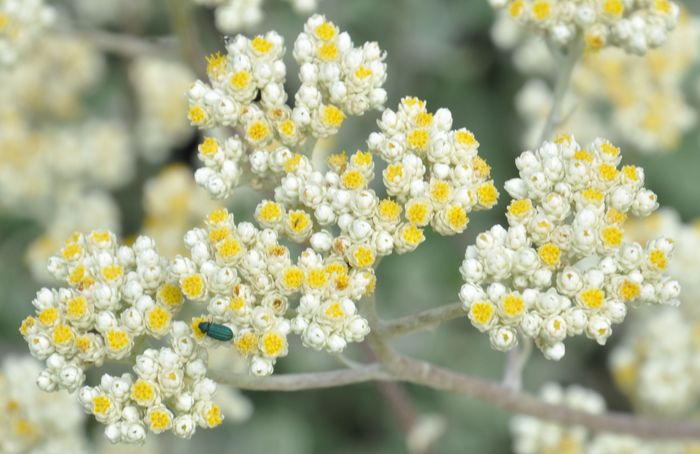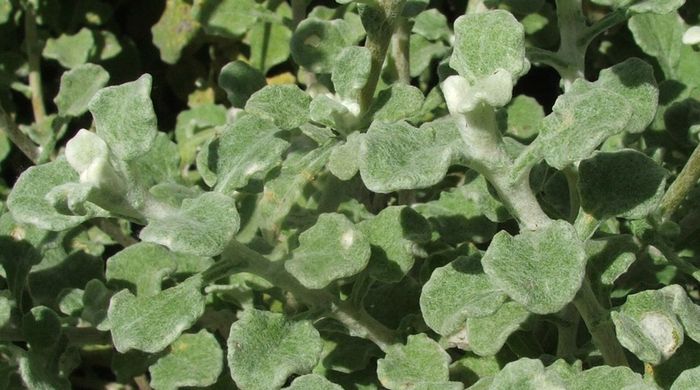Helichrysum petiolare
Helichrysum petiolare Hilliard & B.L.Burtt
Family: Asteraceae
Common names: silver bush everlasting, herbal helichrysum, bedding helichrysum (Eng.), kooigoed, kruie (Afr.), imphepho (Xho.)
Introduction
Helichrysum petiolare is one of the best known and the most commonly used helichrysums, easy to grow, with beautiful velvety silver foliage.

Description
Description
A soft, vigorous shrub, which grows 0.5m - 1m x 1m. The dense, aromatic foliage consists of roundish leaves which are covered with silver-grey hairs.

Many tiny yellow flowers form small flowerheads, surrounded by creamy-white, papery floral bracts, that are arranged in inflorescences, on long stalks, and add to the decorative effect of this plant in midsummer (December and January).

Conservation Status
Status
Helichrysum petiolare, is not threatened.
Distribution and habitat
Distribution description
Helichrysum petiolare occurs in the drier inland parts, sheltered slopes and forest margins of the Western Cape (Cederburg and Jonkershoek Mountains), Eastern Cape and KwaZulu-Natal.

Derivation of name and historical aspects
History
The name Helichrysum is derived from the Greek helios meaning 'sun' and chrysos meaning 'gold', although not all species have golden flowers; petiolare refers to long leaf stalks.
Helichrysum petiolare is one of the best known and the most commonly used members of this genus which consists of about 245 species and is found throughout South Africa. Other members that are sometimes found in gardens include Helichrysum splendidum, Helichrysum argrophyllum, Helichrysum umbraculigerum, Helichrysum populifolium, and Helichrysum nudifolium which is mainly used medicinally.
Ecology
Ecology
The silvery leaves reflect the heat and the hairs help prevent water loss, making this plant very water-wise. The honey-scented flowers attract a variety of pollinating insects, including honeybees. The seeds are small, lightweight, with tuft of bristly hairs at one end, and are dispersed by wind.

Uses
Use
Ailments such as coughs, colds and infections are treated with this popular medicinal plant. The leaves are used by Rastafarians to make an infusion to treat asthma, chest problems and high blood pressure. The smoke of the burning leaves is inhaled as a pain reliever. The leaves are also widely used on wounds to prevent infection.
The Khoikhoi used the leaves and flowers as bedding; campers still do the same today. Burning a mixture of Helichrysum and Artemisia afra leaves, makes a pleasant insect repellent. It is very effective at keeping flies and mosquitoes away.

Growing Helichrysum petiolare
Grow
This plant can be propagated from cuttings or from seed sown in autumn (March). It should be planted in full sun in well-drained soil. This decorative plant spreads rapidly and should be cut back occasionally.
The cultivar Helichrysum petiolare 'Limelight' has luminescent yellow-green foliage in place of the usual grey. It does well in semi-shade and looks good inter-planted with dark coloured foliage plants to create interesting contrasts. It is short lived and need replacing every 2 years.
The small-leaved forms such as the cultivar 'Petite' are as tough and easy to grow as the normal form, but are smaller plants, and more manageable, and better suited to smaller gardens.
References
- Dyson, A. 1994. Getting to know Kirstenbosch National Botanical Garden: Indigenous Healing Plants of the Herb and Fragrance Garden. National Botanical Institute. Cape Town.
- Eliovson, S. 1984. Wild Flowers of Southern Africa: How to grow and identify them. 7th Edition.
- Goldblatt, P and Manning, J. 2000. Cape Plants, A conspectus of the Cape Flora of South Africa, Strelitzia 9. NBI and MBG Press, Pretoria and St Louis.
Credits
Roger Oliver
Harold Porter National Botanical Garden
September 2004
Updated January 2019
Plant Attributes:
Plant Type: Ground Cover, Perennial, Scrambler, Shrub
SA Distribution: Eastern Cape, Western Cape
Soil type: Sandy, Loam
Flowering season: Early Summer
PH: Acid, Neutral
Flower colour: Cream, Yellow
Aspect: Full Sun, Morning Sun (Semi Shade), Afternoon Sun (Semi Shade)
Gardening skill: Easy
Special Features:
Horticultural zones










Rate this article
Article well written and informative
Rate this plant
Is this an interesting plant?
User Comments
Marinda Nel, South Africa
February 12, 2017 at 11:26 AMIt's a firm favourite with me, and I think often undervalued because it is seen everywhere! Would it be happy in a trough overhanging a balcony? And will it take kindly to being pruned regularly?
Alice Notten
March 20, 2017 at 7:34 AMYes and yes.
Breunis Oosterhof, South Africa
June 16, 2017 at 10:57 AMI agree whole heartedly with Marinda, this plant deserves far more attention.
Login to add your Comment
Back to topNot registered yet? Click here to register.